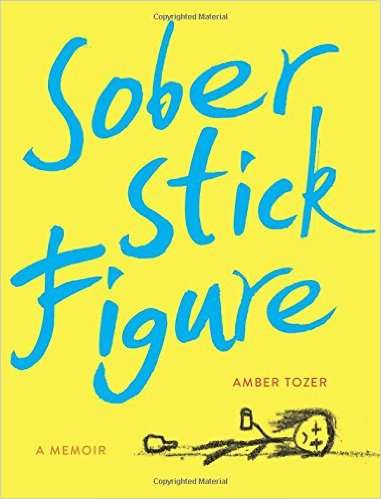Sober Stick Figure by Amber Tozer
Truman Capote once said about drinking, “I drink because it’s the only time I can stand it!” Along with being a quick-witted sassafras and a fabulously talented writer, Capote was a notorious alcoholic. Drinking stifled his creativity and eventually contributed to his death at the age of 59. In the beginning, drinking can open windows of thought and possibility, but too often people rely on it to get them through the day, i.e. Ernest Hemingway, Jack Kerouac, Patricia Highsmith, Tennessee Williams, need I go on?
Stand-up comedian Amber Tozer gives us her story about a life-long affinity for alcohol in the sharply honest memoir Sober Stick Figure (Running Press, May 31, 2016). Having been an alcoholic since her teenage years (but seven years sober now), Tozer doesn’t waste time waxing poetic when describing her addiction. The prose is biting and at times difficult to stomach. But what separates this from so many other memoirs focused on substance abuse is Tozer’s hysterical illustrations. These third-grade level drawings make you burst out laughing after reading about her darkest moments., which is why I wanted to ask her why she drew them to begin with, in this latest addition to the ‘One Question and Answer’ Series.
Question: You made a brave choice with Sober Stick Figure, instead of having straight prose you included hilarious drawings depicting important events in the book. What inspired you to juxtapose such tragically honest prose with these drawings?
 Amber Tozer: Thank you for thinking I made a brave choice! But the truth is – the stick figures were the result of a brainstorming session I had with my agent, Peter Steinberg. We were talking about how we could format a funny book about being a recovering drunk. We started talking about comic books and he asked me if I could illustrate, I said, “No. I could maybe draw a stick figure.” And, the next day he emailed me and said, “I got it! Sober Stick Figure! It’s like Diary of Wimpy Kid but for adults!” And, I thought it was a great idea. Peter is very smart and creative.
Amber Tozer: Thank you for thinking I made a brave choice! But the truth is – the stick figures were the result of a brainstorming session I had with my agent, Peter Steinberg. We were talking about how we could format a funny book about being a recovering drunk. We started talking about comic books and he asked me if I could illustrate, I said, “No. I could maybe draw a stick figure.” And, the next day he emailed me and said, “I got it! Sober Stick Figure! It’s like Diary of Wimpy Kid but for adults!” And, I thought it was a great idea. Peter is very smart and creative.
When I wrote the first draft of the first chapter I skimmed over the dark stuff. I didn’t really dig in to the truth and unearth it. I thought because of the stick figures, the writing should also be on the lighter side. But, after experimenting with the tone of it, it was much more interesting when the funny childish stick figures juxtaposed the dark truth. The more honest the text, the funnier the stick figures. It was emotional and draining to write the book, but when I was drawing the stick figures I couldn’t help but laugh a lot. Not, because I think I’m so funny but because they are so bad. I’ve always been horrible at drawing and to think I’d ever work on a book where I had to illustrate over 250 drawings is just nuts to me.
I didn’t realize this when I was writing it, but I think the stick figures offer a second voice to the book. Like the voice of a child who sees the situation in a silly way, as if she is watching the story play out from outer space or on a movie screen. The stick figures give a ridiculous visual snap shot of what’s going on in a more matter of fact than emotional way. There is also a lot of dialogue between the stick figures, offering another platform for jokes. For example, if the paragraph was about getting drunk alone and watching Sex in the City and wanting to kill myself – the illustration could be two stick figures with one saying, “Should I kill myself?” And the other one saying, “Maybe after Miranda tells Carrie about her one-night stand.” To me, it’s being honest about wanting to die and the stick figures make that tragedy funny because they are cool with it, but they think watching Sex in the City is more important than killing yourself. I don’t know, that’s just funny to me.
But, overall – I hope the stick figures offer a lighter approach to alcoholism. Addiction is such a heavy topic. It’s tricky and awful and crazy so I hope in some way my book explains the madness in a way people can relate to, but also laugh at. I don’t think alcoholism itself is funny, but I do think laughing a lot in recovery is a crucial part of the healing process. Oh my God, did I just say “healing process”? Sorry. OK, I think that’s all I’ve got. Thank you for your time. Best wishes to everyone!
Author Photo Credit: Dan Chapman
Buy this Book!
Amazon







